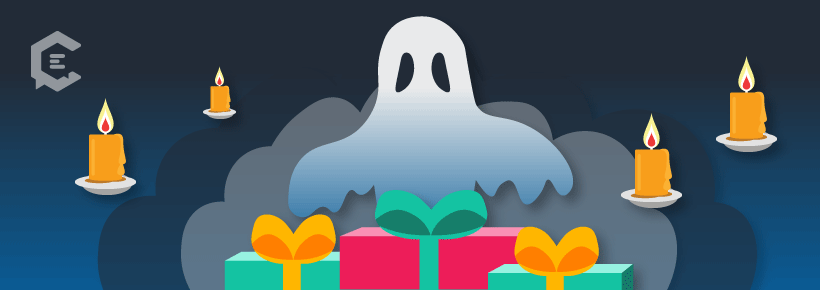In Charles Dickens’ ‘A Christmas Carol,’ Ebenezer Scrooge is visited by three ghosts — the Ghost of Christmas Past, the Ghost of Christmas Present, and the Ghost of Christmas Future. Each ghost plays a role in teaching Scrooge to learn from, embrace, and look forward to life.
We’re not calling you a scrooge, but if the holiday marketing season causes you to say “bah humbug,” perhaps there are a few lessons in store for you as well. So, what can you learn with your marketing efforts this holiday season? Let’s take a trip with the Ghost of Content Marketing Past, the Ghost of Content Marketing Present, and the Ghost of Content Marketing Future to find out how you can learn from, embrace, and look forward to your content marketing efforts.

Ghost of Content Marketing Past
You only need to travel back to the 2017 holiday season to learn some valuable lessons that can change your perspective on your holiday content marketing livelihood. Online sales during the 2017 holiday season were the highest on record. In fact, more than $108 billion of online sales were generated in November and December of 2017 in the United States, a nearly 15 percent increase from the prior year.
And what were the two marketing tools that led to the most revenue?
- Paid and organic search campaigns: Paid and organic search brought in more revenue in the 2017 holiday marketing season than any other tactic. Search brought in a total of nearly 45 percent of all online holiday visits, with paid search accounting for 23.5 percent and organic for 21.3 percent.
- Email campaigns: Email also was an effective tool for creating online holiday site experiences. Approximately 1 in every 5 online visits in the 2017 holiday season were attributed to email marketing efforts.
Ghost of Content Marketing Present
It can be easy to think of the 2018 holiday season as being several weeks long, but perhaps there are better ways for you to organize your marketing calendar this holiday season. One potential way to focus your content marketing efforts is to hone in on a few key dates rather than thinking about the “holiday season” as a giant collection.
By focusing on key dates, you can create sub-campaigns that play a role in your larger holiday season campaign. You would be wise to continually check yourself to ensure that your sub-campaigns support your overarching holiday season marketing campaign. The dates you choose to focus on will vary depending on your goals, but a few of the days you may want to explore include:
- November 22 — Thanksgiving: A great day to reach people gearing up to shop.
- November 23 — Black Friday: The biggest shopping day of the year in the United States.
- November 24 — Small Business Saturday: A day when shoppers are looking to support local stores.
- December 10 — Green Monday: This is traditionally the best sales day of December.
- December 14 — Free Shipping Day: A big day for shoppers who don’t want to pay to ship.
- December 22 — Super Saturday: Also known as “Panic Saturday.”
- December 26 — Day After Christmas: The last billion-dollar shopping day of the year.
Ghost of Content Marketing Future
The best way to plan for and look forward to your 2019 holiday season content marketing is by learning in the moment during the 2018 season and then later examining the success of your efforts after the holiday season calms down.
Additionally, you should keep an eye on the trends and tactics that start to gain traction during the 2018 season. Light testing with new trends can help you down the road when these trends may become a more important part of your holiday marketing efforts. A couple of the trends you may want to experiment with in 2018 and use more extensively in 2019 and beyond include:
• Voice search: We already told you paid and organic search made up for 45 percent of online visits in 2017, but voice search is the trend-setting tactic that experts predict will come on strong in 2019 and beyond. ComScore estimates that by 2020 half of all searches will be by voice. Considering now how Siri, Alexa, Google Home, and Cortana can help you now will be especially advantageous in future holiday seasons.
• More personalized personalization: If you are asking your customers the right questions and you are collecting the right information, then you probably already include an element of personalization in your marketing efforts. However, due to the growing digital footprint of online consumers, the opportunity to personalize content in meaningful ways will become even more prevalent.
How can you be confident that personalization will grow? Because customers want it. Nearly 1 in 3 consumers say they wish their shopping experience were more personalized than it currently is. Do what you can now to personalize, but also stay aware of new personalization opportunities as they present themselves in upcoming years.





